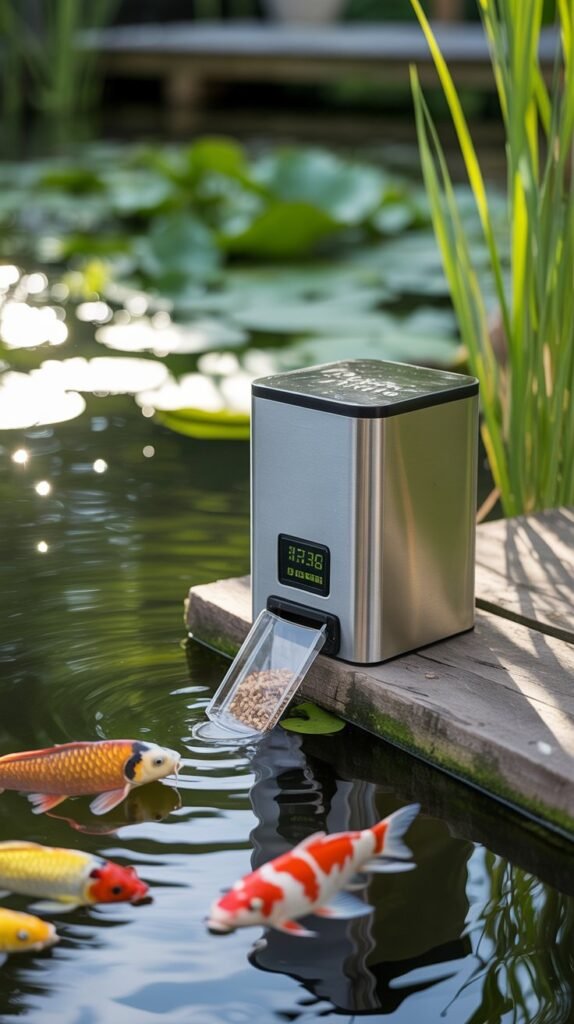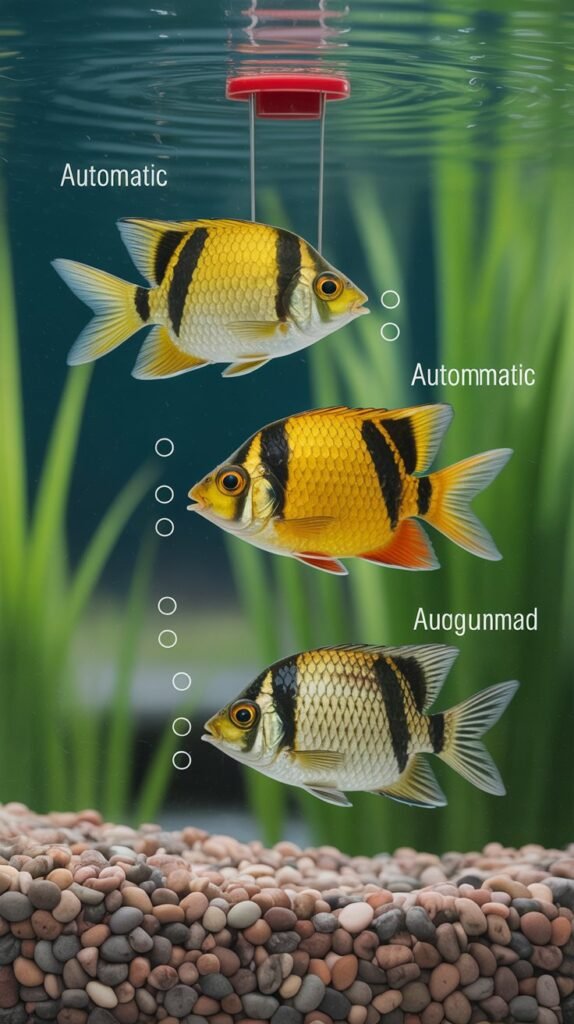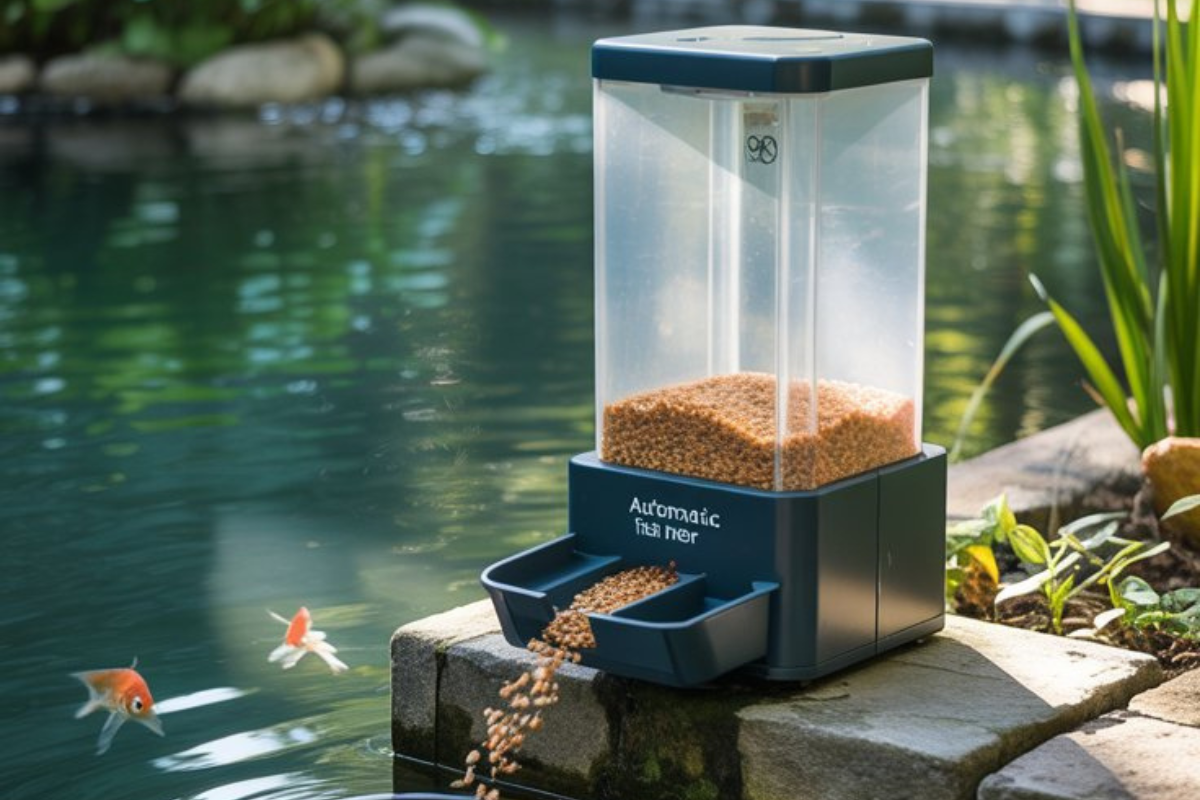Keeping an aquarium is a rewarding hobby, but one of the most common challenges aquarists face is maintaining a consistent feeding schedule. Fish thrive on routine, and irregular feeding can lead to stress, aggression, or even health problems. What happens if you go on vacation, get caught up in work, or simply forget feeding time? This is where an automatic fish feeder becomes an invaluable tool.
An automatic fish feeder is a device designed to dispense fish food at scheduled times, ensuring your fish get regular meals even when you are not around. Whether you keep freshwater fish, saltwater species, or a heavily stocked community tank, an automatic feeder can make aquarium care far more convenient and reliable.
In this article, we’ll explore the benefits, types, setup tips, buying guide, and maintenance of automatic fish feeders, along with some FAQs at the end.
What is an Automatic Fish Feeder?

An automatic fish feeder is an electronic or mechanical device that dispenses pre-measured amounts of fish food into your aquarium at scheduled times. Most models are battery-operated, while some plug into electrical outlets. They can handle different types of fish food, including flakes, pellets, and freeze-dried foods.
These feeders can be programmed to release food once or multiple times a day, ensuring your fish never miss a meal.
Benefits of Using an Automatic Fish Feeder
1. Consistent Feeding Schedule
Fish thrive on routine. Automatic feeders ensure they receive food at the same time every day, even if you’re away.
2. Perfect for Vacations or Busy Lifestyles
Going on holiday or working long hours? An automatic fish feeder keeps your fish fed without needing a sitter.
3. Prevents Overfeeding
Overfeeding is a common mistake in fishkeeping that leads to poor water quality, obesity, and disease. Automatic feeders dispense controlled portions, reducing this risk.
4. Suitable for Multiple Feedings
Some fish, like fry or small tropical species, require frequent meals. Automatic feeders can be programmed for several feedings throughout the day.
5. Works with Different Food Types
Most automatic feeders can handle pellets, flakes, or crumbles. Some advanced models also dispense freeze-dried or powdered foods.
6. Improves Water Quality
By preventing excess food from entering the tank, automatic feeders help maintain stable water parameters and reduce ammonia buildup.
7. Convenience and Peace of Mind
Even when you’re at home, an automatic feeder saves time and ensures you never forget a feeding.
Types of Automatic Fish Feeders

There are several types of automatic fish feeders available, each with unique features and functions.
1. Drum-Style Feeders
- The most common type.
- Food is stored in a rotating drum that releases portions at set intervals.
- Ideal for flakes, pellets, and granules.
2. Portion-Control Feeders
- Food is stored in multiple compartments.
- Each compartment dispenses at a programmed time.
- Great for varied diets or medication schedules.
3. Pond Fish Feeders
- Larger, weatherproof feeders designed for outdoor ponds.
- Dispense big quantities of food for koi, goldfish, or other pond fish.
4. Tube Feeders
- Food travels down a tube directly into the tank.
- Reduces floating debris and prevents food from drifting away in currents.
5. Smart Automatic Feeders
- Wi-Fi or Bluetooth-enabled.
- Controlled via smartphone apps.
- Allow remote feeding adjustments and monitoring.
How to Use an Automatic Fish Feeder
Step 1: Choose the Right Feeder
Consider your fish species, tank size, and preferred food type.
Step 2: Set It Up Correctly
- Mount it on the aquarium rim or hood.
- Ensure food dispenses into the water, not outside the tank.
Step 3: Program Feeding Schedule
- Set the desired number of feedings per day.
- Adjust portion sizes according to your fish’s needs.
Step 4: Test Before Relying on It
Run the feeder for a few days while you’re home to make sure it dispenses the correct amount.
Step 5: Regular Maintenance
- Refill the feeder when food runs low.
- Clean it regularly to prevent clogs and mold.
Best Food Types for Automatic Fish Feeders

While feeders are versatile, some foods work better than others:
- Pellets: Best option since they dispense evenly.
- Granules: Work well in most feeders.
- Flakes: Can clump together; best used with drum-style feeders.
- Freeze-dried food: Possible but may clog if humidity builds up.
- Live and frozen foods: Not suitable for automatic feeders.
DIY Automatic Fish Feeder Ideas
If you enjoy DIY projects, you can even build a homemade feeder:
1. Timer-Controlled Motor
Attach a small motor to a food container with holes. The motor rotates the container on a timer, releasing food.
2. Gravity Feeder
Use a plastic bottle with small holes cut at the bottom. As fish eat, more food naturally drops down.
3. Arduino-Powered Feeder
For tech-savvy hobbyists, program an Arduino microcontroller to rotate a food dispenser at set times.
Automatic Fish Feeder in Freshwater vs. Saltwater Tanks
Freshwater Tanks:
- Ideal for tropical fish, community tanks, and fry.
- Prevents food from sinking too quickly in planted setups.
Saltwater Tanks:
- Useful for feeding clownfish, tangs, and other reef species.
- Keep the feeder away from salty moisture to prevent corrosion.
Tips for Getting the Most Out of Your Automatic Fish Feeder
- Use High-Quality Food – Prevents clumping and ensures smooth dispensing.
- Keep It Dry – Moisture is the enemy of automatic feeders. Use a cover if necessary.
- Avoid Overloading – Only fill the hopper with a week’s worth of food to maintain freshness.
- Position Carefully – Ensure food falls into the tank, not on the lid or outside.
- Combine with Feeding Rings – A feeding ring helps keep dispensed food in one place.
Pros and Cons of Automatic Fish Feeders
Pros:
- Consistent feeding schedule.
- Reduces overfeeding risks.
- Convenient for vacations and busy lifestyles.
- Supports multiple feedings per day.
- Improves water quality by reducing excess food.
Cons:
- Not suitable for live or frozen foods.
- May malfunction if not tested properly.
- Requires batteries or power supply.
- Some models are noisy.
Buying Guide: Choosing the Best Automatic Fish Feeder
When shopping for an automatic fish feeder, consider:
- Food Compatibility – Does it support pellets, flakes, or both?
- Tank Size – Small feeders for nano tanks, large feeders for big aquariums or ponds.
- Programmability – Ability to set multiple feeding times.
- Power Source – Battery-operated vs. plug-in models.
- Build Quality – Durable and moisture-resistant design.
- Ease of Cleaning – Removable food compartments are easier to clean.
- Smart Features – Wi-Fi control and app integration for advanced users.
Maintenance and Troubleshooting
- Clean Regularly: Prevents mold and clogs.
- Check Battery Levels: Replace batteries on schedule.
- Monitor Food Quality: Avoid damp or expired food.
- Test Before Trips: Always test the feeder before leaving for vacation.
- Avoid Overstuffing: Too much food can jam the dispenser.
FAQs About Automatic Fish Feeders
1. What is the best food for automatic fish feeders?
Pellets and granules are best since they dispense evenly without clogging.
2. Can I use flakes in an automatic feeder?
Yes, but flakes may clump. Drum-style feeders work best for flakes.
3. How many times a day should I set the feeder?
Most community fish do well with 1–2 feedings per day. Fry or small species may need 3–4.
4. Can I use an automatic feeder for my pond fish?
Yes. Outdoor pond feeders are available for koi and goldfish.
5. Are automatic fish feeders safe?
Yes, if used properly. Always test before relying on them for long trips.
6. Can I feed frozen or live food with an automatic feeder?
No. Automatic feeders only work with dry foods like pellets, flakes, or freeze-dried items.
7. How long can an automatic feeder last without refilling?
Depending on the model, most last 1–4 weeks before needing a refill.
8. Do automatic fish feeders work in saltwater tanks?
Yes, but place them in a dry spot to avoid salt corrosion.
9. Do I still need to manually feed my fish?
You can, but the feeder can fully manage feeding if programmed correctly. Some aquarists like to hand-feed treats occasionally.
10. Where can I buy an automatic fish feeder?
They’re available in pet stores, aquarium shops, and online platforms like Amazon, Chewy, and eBay.
Conclusion
An automatic fish feeder is one of the most valuable tools in modern fishkeeping. It ensures your fish are fed consistently, reduces waste, improves water quality, and provides peace of mind whether you’re at home, at work, or on vacation.
With options ranging from simple drum-style feeders to advanced smart devices, there’s an automatic fish feeder for every aquarium type and budget. By choosing the right model, setting it up properly, and maintaining it regularly, you can enjoy a healthier aquarium and happier fish while simplifying your daily routine.

